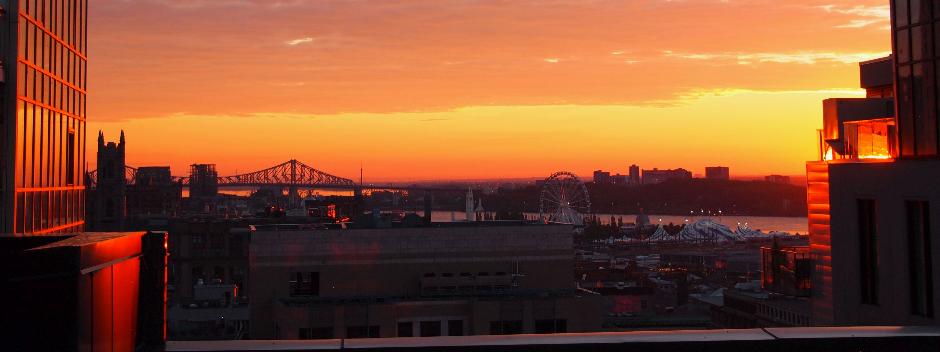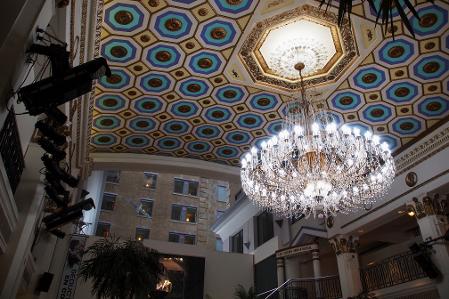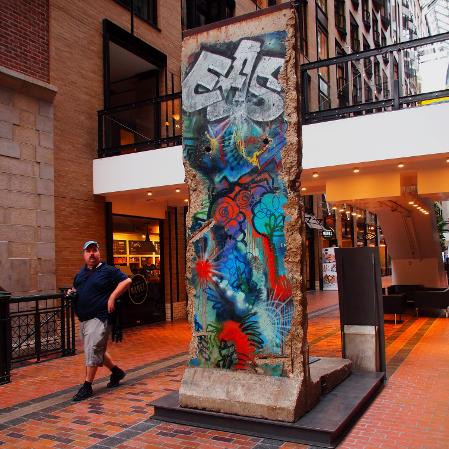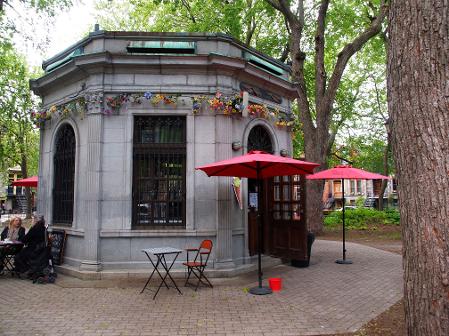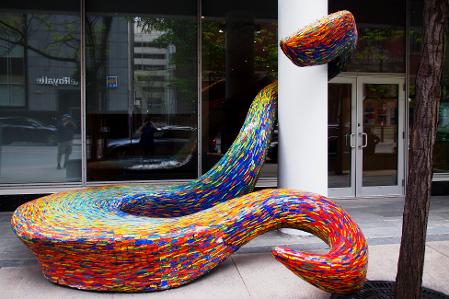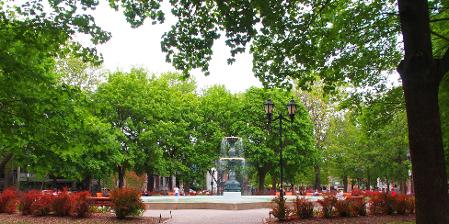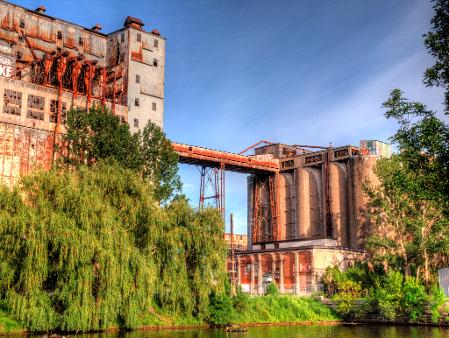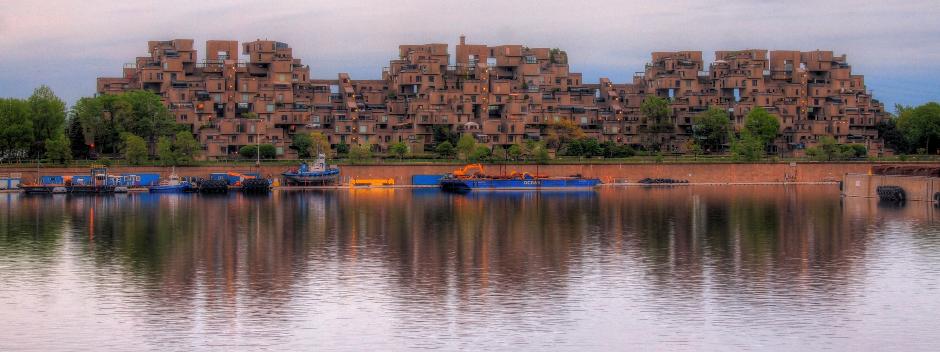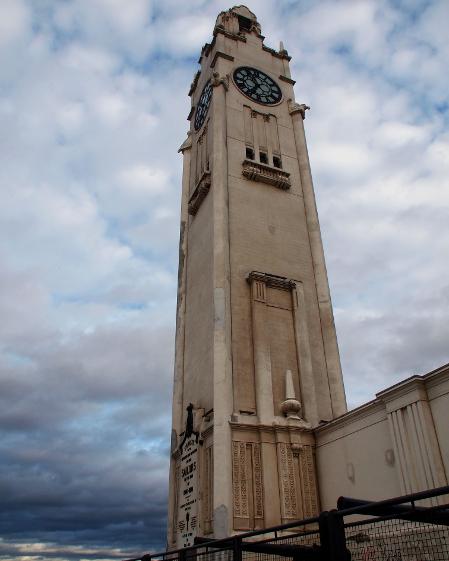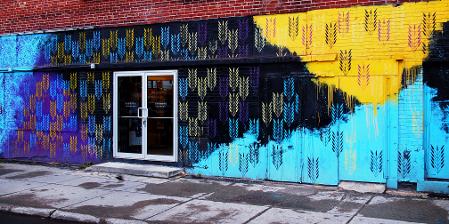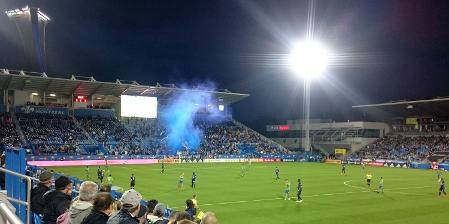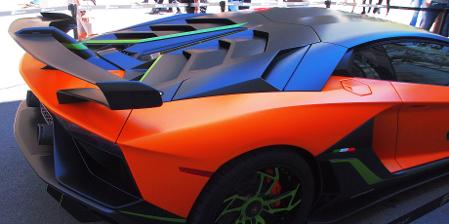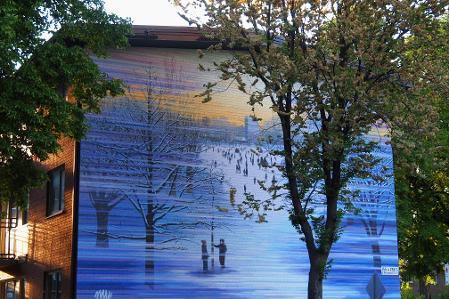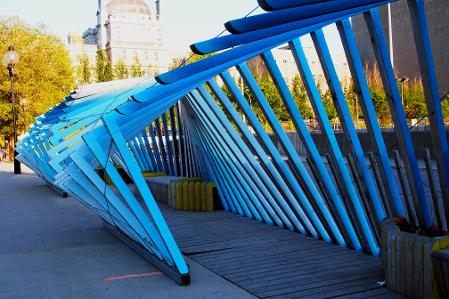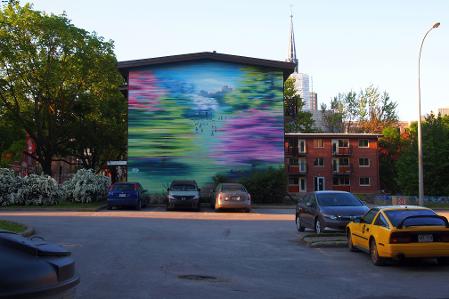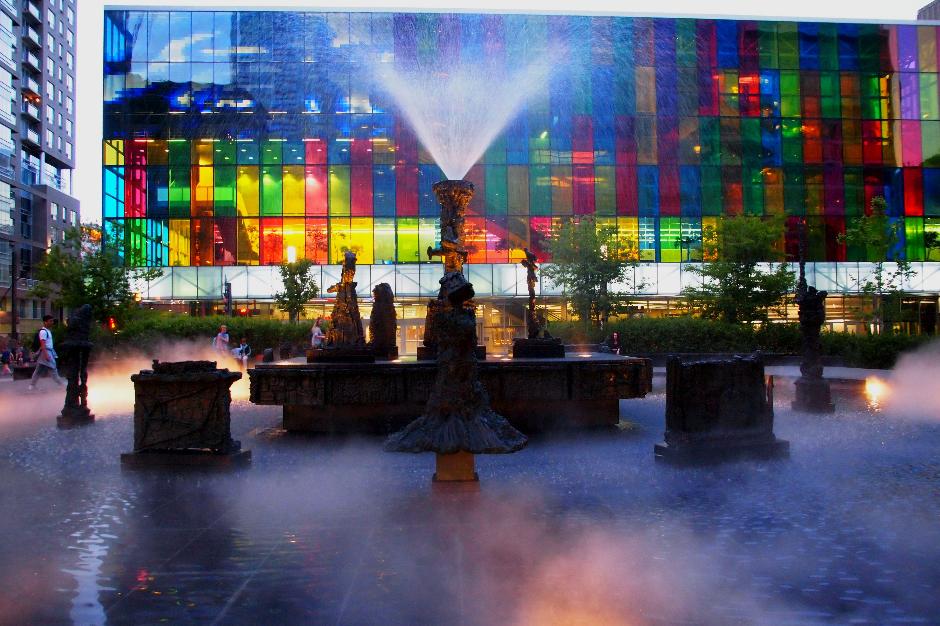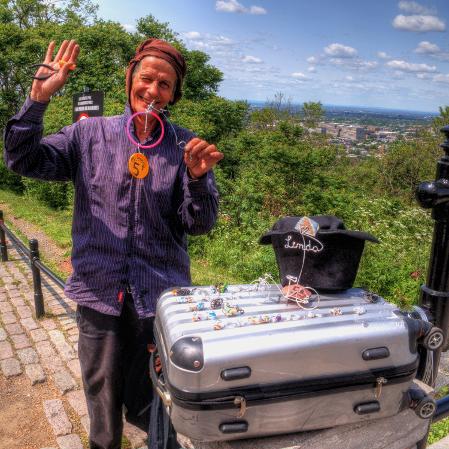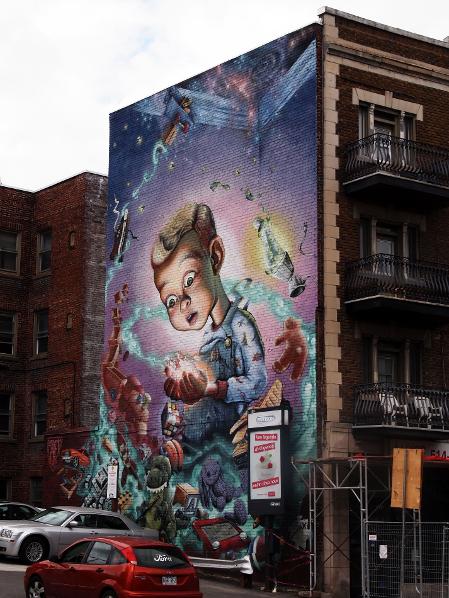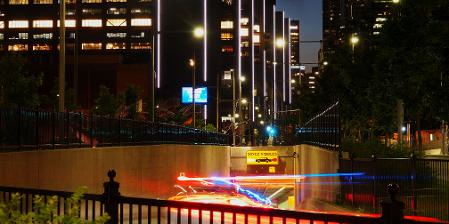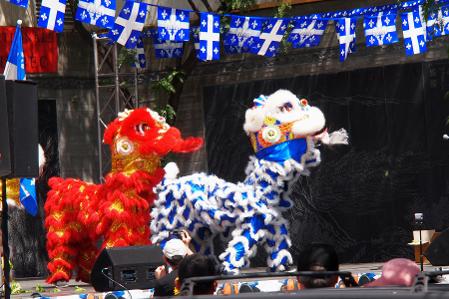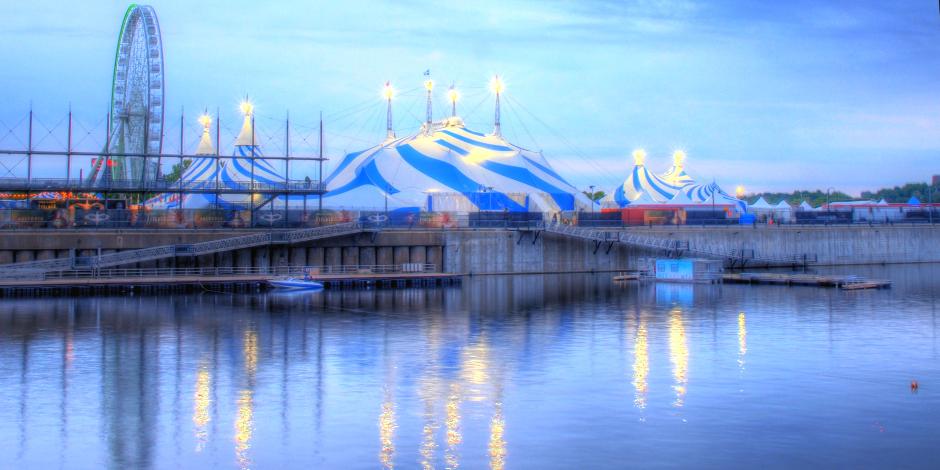City Of Art
Olympus E-PL1: f6.3, 1/100 sec, ISO 100 // IrfanView: Crop, Colour Balance
As dawn illuminates the city from my building's rooftop patio, I never know what adventures await. Even after three months in this city, there are vast areas and small corners still to be discovered. In June I had some company on my explorations. My best friend came to visit at the start of the month, and my parents stopped in near its end. I was glad to host them and provide a taste of Montréal, though both times I felt bad that there was so much which simply could not be covered in a two-day tour.
There is a segment of the Berlin Wall displayed at Montréal's World Trade Centre. Once a symbol of division and oppression, now it is the gravestone of a collapsed regime; a reminder not to repeat the mistakes of the past. The concrete barrier has one face nearly covered in graffiti and the other nearly bare, and it makes me uneasy. It feels odd for it to have become just another photographic opportunity.
Olympus E-PL1: f4, 1/60 sec, ISO 200
IrfanView: Crop, Colour Balance
Olympus E-PL1: f4.1, 1/60 sec, ISO 500
IrfanView: Crop, Colour Balance
Enough of walls and other weighty subjects! This scintillating chandelier illuminates the ornate atrium in Les Cours Mont-Royal, the city's most posh shopping mall. Beneath it is a runway, a chic spot for the debut of the stylish designs for which the city is known.
Public art is ubiquitous in Montréal, making it a splendid destination for photographers like my friend and me. I would not hazard to pick my favourite piece, but if I did, this vibrantly-coloured snake (which is also a bench) would be in the running for sure.
Olympus E-PL1: f5, 1/100 sec, ISO 200
Just past the pavilion is a lovely fountain in a classic European style. It works perfectly as the centerpiece of the urban recreational park. In such a place, it is easy to picture historic generations of people enjoying Saturday afternoons, summer after summer, since the park opened in 1876.
Olympus E-PL1: f4.1, 1/80 sec, ISO 200
IrfanView: Crop, Colour Balance
One place that my friend and I explored which I had never visited was Square Saint-Louis. At its centre is a cute octagonal pavilion with a tiny shop inside. It's a grand place to pick up some ice cream for a day in the park.
Olympus E-PL1: 6.3, 1/160 sec, ISO 200
IrfanView: Crop, Colour Balance
Below is a last-minute capture of an unexpected treat, a flyover by the Snowbirds as we were touring around outside the Biodome at Olympic Park.
Olympus E-PL1: f10, 1/500 sec, ISO 200 // IrfanView: Crop, Colour Balance
We visited the Old Port. It is a preserved historic neighbourhood with stately buildings from the nineteenth and early twentieth centuries. The Old Port is centered around Notre-Dame Basilica, which opened in 1829. A stone's throw away from that is another "old port", the dilapidated grain towers along the Lachine Canal. Given the prime location, I am led to wonder how long they will stand before being replaced by some new, gleaming development. I must say I am not sure how I feel about such a possibility. Do these wrecks hold value as they are? Would they still, if somehow they were retrofitted to a new use?
From our vantage point in the Old Port we looked across to Habitat 67. I included a close-up of the architectural gem in my April post. Now,here is the full structure:
Olympus E-PL1: f16, ISO 200 // IrfanView: Crop, Colour Balance // PhotoMatix: HDR Toning
The Montréal Clock Tower is also located in the Old Port. It was on my to-do list for when my parents came, though sadly we did not get there (It is on the very end of the last pier). It was built as a monument, with the following inscription:
TRIBUTE to the heroism and devotion of our sailors in the war of 1914-1918
Moving inland, my friend and I also visited the Marché Jean-Talon, the city's most renowned farmers' market. We joked that he had been sent by plane on a grocery shopping trip; he had a list of local delicacies to bring home. He found it all at Jean-Talon.
My pal had a particular interest in capturing murals, which contrasted nicely with my fondness for statuary. Thanks to his influence, I took the below two pictures near Jean-Talon Market.
My friend and I did not make it to a Montréal Impact game, but I did go again with a coworker. I am including this shot because it shows the Olympic Tower rising just behind Saputo Stadium and also one of the puffs of blue smoke that regularly waft over the super-fan sections behind the nets. Now, if only you could hear the chants and feel the stadium shaking with stomping feet!
Sony Xperia Z3c: f2, 1/100 sec, ISO 160
IrfanView: Crop, Colour Balance
The weekend after my friend's visit was when the Formula 1 came to town. I have never been much into auto racing. Still, I did enjoy it when they shut down a street near my office and filled it with supercars to gawk at. As much as I loathe the internal combustion engine, there is no denying that even as sculpture, the Lamborghini Aventador is an impressive work of engineering.
Olympus E-PL1: f5.6, 1/160 sec, ISO 200
IrfanView: Crop, Colour Balance
I suspect this nifty twisting structure cost much less than a Lambo, yet it also fascinated me. At free, it's also much less expensive to get inside!
Olympus E-PL1: f5.1, 1/160 sec, ISO 200
IrfanView: Crop, Colour Balance
There is a group of row houses just North of the downtown core. I think they are part of a co-op, or perhaps a public housing scheme. Each one features a whole-wall mural in dreamy pastel colours. One thing about Montréal that really impresses me is how not a single opportunity for public art seems to be overlooked.
The Congress Centre is a large convention hall located near my apartment. Across the street from its coloured-glass façade is a fountain called La Joute, 'The Joust'. Originally installed at the Olympic Park, it was moved downtown as part of a redevelopment to attract more people to the central business district. I have yet to see the fountain in its full glory; it is supposed to have flame spurts. Still, it is lovely even when only the water is running. It has a 32-minute sequence of bubbling, spraying, and mist.
Olympus E-PL1: f4, 1/40 sec, ISO 1600 // IrfanView: Rotate,Crop, Colour Balance
On June 16, 2019 I went to eat at a Georgian restaurant outside of downtown. I will spare you the shot of my Imeretian khachapuri (though it was delicious!) and instead share an imaginative wall mural that I saw along my way.
Olympus E-PL1: f8, 1/500 sec, ISO 200
IrfanView: Crop, Colour Balance
PhotoMatix: HDR Toning
Mount-Royal Park has two lookoffs. The most famous is the Kondiaronk Belvédère, which overlooks downtown. At a somewhat lower elevation is the Camillien-Houde Belvédère, from which one can see Olympic Park in the distance. Oftentimes, Jean the wire-bender is at Camillien-Houde. He plies little mementos; notably bicycles and jewellery. Ever friendly, he let me take his portrait.
The busy Boulevard Henri-Bourassa is a main traffic artery that feeds downtown. In the Montréal thinking, that makes it the perfect spot for some art. Between the multi-lane veins of traffic is a linear park, at one end of which is this sculpture, called Source. Behind it, the Farine Five Roses sign is visible above the old wheat towers.
Olympus E-PL1: f16, 8 sec, ISO 200
IrfanView: Colour Balance
Here, a stream of police cars enter the tunnel which connects Henri-Bourassa to Boulevard Ville-Marie. The building on the left is Place Bonaventure, which connects to Central Station. The train is above the road, and the road is on the surface and in the tunnel. There's a Metro line under the road tunnel, and below that is where my new commuter transit line is being built! Additionally, Place Bonaventure is part of the RÉSO, so it has underground pedestrian links, too.
Montréal exists in a strange place - Quebec. The province has a staunch aversion to outside influences, and maintains a fierce grip on its language and culture. In contrast, a love of all culture, regardless of its origin, is the beating heart of artistic Montréal. Where else but in this city could the "national" holiday of the Fête de la Saint-Jean-Baptiste be celebrated with a Chinese dragon dance? I enjoyed this show while sipping a bubble tea in Chinatown. Alas, the shot is a bit blurry;my hands were full and I was at the far end of a large crowd watching the performance.
Below may be my favourite photograph from my entire time in the city. It is the Cirque Du Soleil tent and the Grand Roue on a pier of the Old Port. I got to go inside the tent and see the Cirque show; it was amazing! I was so enthralled, I did not take any pictures. I do not mind, though. This scene, with the lights dancing on the water as if in an impressionist painting, provides a splendid visual memory.

